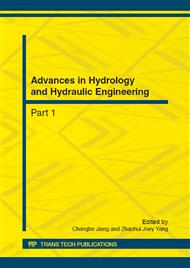p.3
p.10
p.20
p.25
p.33
p.40
p.46
p.50
Multi-Threshold Regression Reference Evapotranspiration Prediction Model Study Based on PSO Algorithm
Abstract:
In order to overcome the difficulties existing in estimating the multiple threshold values in multiple threshold regression models, a new Multi-threshold regression prediction method is proposed using Particle Swarm Optimization (PSO) in this paper, realizing estimating the multiple threshold value of multi-threshold regression (MTR) model. This method expands the prediction factors at the beginning, reduces the dimension using principal components analysis, searches threshold value by PSO and then establishes threshold regression model. A set of common modeling solutions of MTR is presented based on PSO at the same time. And this modeling solution is applied to the prediction of Reference Evapotranspiration (ET0) in the Panjin area. Results indicate this model has high precision for prediction and its application will provide a new means for predicting annual cumulative ET0.
Info:
Periodical:
Pages:
25-32
Citation:
Online since:
October 2012
Authors:
Price:
Сopyright:
© 2012 Trans Tech Publications Ltd. All Rights Reserved
Share:
Citation:


